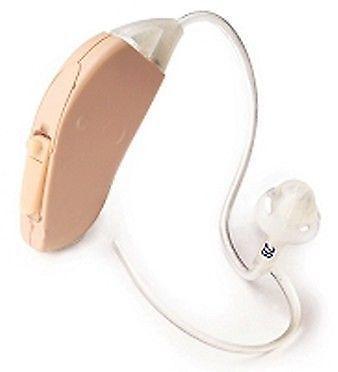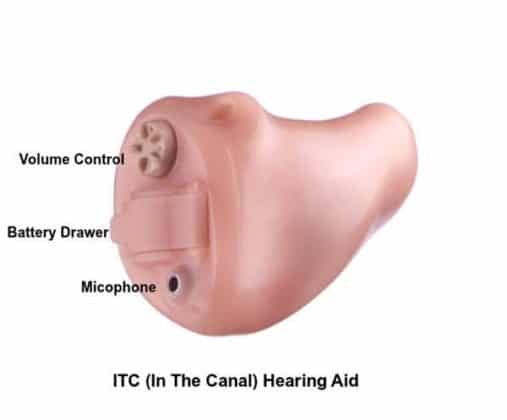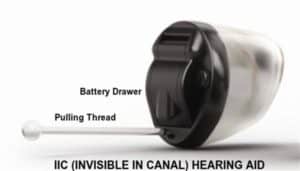You have visited the Audiologist and the final advice is to buy a Hearing Aid Machine. Do not worry if your knowledge of Hearing Aids is an occasional glance at an advertisement. This article will update you on the basics of Hearing Aid Devices.
It is important for you to know the different types of Hearing Aids available. A well-informed user can make a better choice.
What Is A Hearing Aid?
A hearing Aid is a device which helps people with Hearing Loss to hear much better. It is an electronic device consisting of a circuit and other components. It amplifies the sound signals or speech picked up by the microphone. Hearing Aids reproduce the selected sounds louder. This allows the person with hearing loss to listen to sounds which he or she was earlier missing out on. This allows the person to conduct all the activities as a person with a normal hearing.
How Does a Hearing Aid Work?
The Microphone picks up the Sound or Speech signal. These signals get amplified by the circuit and reach the Receiver. The Receiver converts the electronic signals into audio signals or sounds as we hear it.
What Are The Main Parts Of A Hearing Aid?
There are 3 main parts in a Hearing Aid.
1. Hearing Aid Microphone
The Microphone picks up the speech or sound signals. The Microphone converts the speech into electrical signals.
2. Hearing Aid Amplifier
The Amplifier receives the Speech signals from the Microphone. As the name suggests these signals get amplified.
3. Hearing Aid Receiver
A Receiver is a part which finally converts the amplified electrical signal to sound. The word Receiver is generally used only for Hearing Aids. It is basically a small speaker or a transducer.
How Do Hearing Aids Help?
Hearing Aids help by amplifying the sound. Thus, helping persons suffering from hearing loss to hear well.
The greater the hearing loss, the greater the hearing aid amplification required. Even high amplification does not help when the hair cells are not functioning. In this case, the ENT Doctor recommends a Cochlear Implant.
What Are The Different Styles of Hearing Aids
- BTE or Behind the Ear Hearing Aids
- Open Fit BTE Hearing Aids
- RIC (Receiver in the Canal) BTE Hearing Aids
- In-The-Ear (ITE) Hearing Aid
- In the Canal (ITC) Hearing Aids
- Completely in Canal (CIC) Hearing Aids
- Invisible in the Canal (IIC) Hearing Aids
BTE Or Behind the Ear Digital Hearing Aids

BTE or Behind the Ear Hearing Aids fit behind the ear of the user. The outer body or the housing is of a plastic compound and is very sturdy. The housing is in the shape of the back of the ear and fits comfortably behind the ear.
The part above the housing is the Ear Hook, this holds the Hearing aid in place. A Silicon tube connects to the ear hook with the Ear Mold at the end of the tube.
The Mold is custom made or made as per the size and shape of the user’s ear. It fits inside the Outer Ear or Concha. The Microphone, Receiver, Volume Control, Switches and the electronic circuitry fit inside the body.
People of all ages can use BTE Hearing Aids, they are suitable for all types of Hearing Loss.
The BTE Hearing aid is not very visible as the housing is generally covered by the ear flap. Only the silicon tube from the Ear Hook to the entrance of the Ear Canal is somewhat visible. The material of the tube is clear silicon which further reduces the visibility.
Open Fit BTE Digital Hearing Aids

BTE or Behind the Ear hearing Aids can be further classified as conventional BTE and Open Fit BTE
The difference between a conventional BTE and an Open Fit BTE is in the tube and the Ear Tip.
In the conventional BTE, the ear tip or Ear Mould seals the opening of the Ear Canal.
In an open fit BTE, the tip has holes or openings in it to allow the sound to escape or come out. The low-frequency sound waves escape through the holes avoiding occlusion effect.
People with high-frequency loss normally use Open fit BTE hearing Aids.
This style of Hearing aid is less visible than the conventional BTE as the tube is thin and the ear tip is very small.
RIC (Receiver in the Canal) BTE Digital Hearing Aids

These are popularly known as RIC or RITE (Receiver in Canal or Receiver in The Ear).
In the conventional BTE Hearing Aids, the receiver is in the body of the Hearing Aid. The Silicon tube carries the sound into our ear. In case of RIC/RITE, the receiver fits in the ear.
The receiver in this case, is closer to the eardrum. This design delivers higher power with lesser distortion.
What Are Custom Made Digital Hearing Aids?
A custom made Hearing aid is as per the shape and size of the user’s ear. The dispenser sends the ear impression of the user to the Company. The Hearing Aid Companies process the same in their Shell making Laboratories.
These labs make a hollow shell of acrylic material as per the impression of the ear. In the process, they keep the shape and contours of the ear.
The circuit is then placed into the hollow cavity. The basic stages and components are the same as other types of Hearing Aids.
These type of Hearing Aids are not very visible except the Faceplate. The Faceplate is the part where the Volume control, microphone and the battery drawer is present.
Types Of Custom Digital Hearing Aids
There are 4 types of Custom Hearing Aids. The basic difference is in the style or size of the Hearing Aid.
In-The-Ear (ITE) Digital Hearing Aids

An ITE or In the Ear Hearing Aid is a custom Hearing aid. It is smaller than a BTE. The shell or the housing is of the shape and size of the user’s ear. The complete Hearing Aid fits in the Concha or the outer ear.
In The Canal (ITC) Digital Hearing Aids

The ITC or In the Ear Hearing aid is also a Custom Hearing Aid. The principal of the ITC is the same as the ITE. The components are further miniaturized, and the size is smaller than the ITE. The major part of the Hearing Aid fits into the Ear Canal, only the faceplate is visible. The controls and the battery insertion drawer is on the face plate.
The electronic process of amplification remains the same as other Hearing Aids. Due to technological advancements, the size of the components have become smaller. This makes the Hearing less visible.
Completely In Canal (CIC) Digital Hearing Aids

The components are further miniaturized in a CIC. The CIC Hearing Aid fits into the Ear Canal and is barely visible. Even the Faceplate is hardly visible. Most of the manufacturers do not provide a volume control or any controls as the size is very small.
Since the Hearing Aid fits into the Ear Canal, it is not visible at all. A nylon pulling thread fixed to the Hearing Aid helps the user to pull out the Hearing Aid.
Invisible In The Canal (IIC) Hearing Aids

This is the latest technology in the industry. Not all companies have the know-how to make this very small Hearing Aid. The Hearing Aid fits very close to the Eardrum and nothing is visible outside. The components are very small.
As in the CIC, an IIC also has a pulling thread as the Hearing Aid sits deep into the canal.
Digital technology has been a boon for the hearing aid industry. The latest hearing Aids have electronic circuits which are like small computers. They analyze the incoming signals and separate the unwanted noise from the speech signals. The features available in Digital Hearing Aids increase the users comfort level and acceptability.
